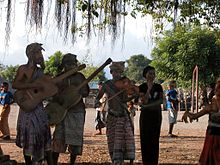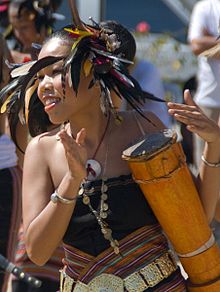Music in East Timor
The music of East Timor reflects the influence of foreign rule that the country was under for almost 500 years. Portuguese and Indonesians both brought their music such as fado and gamelan with them. There is also a rich traditional dance culture. Drums and other percussion instruments are mainly used for them, but guitars, violins and horns are also used.
Ritual music

One of the traditional dances is the Likurai dance, which was originally performed by the women for the men returning from the war. The dance was accompanied by a snare drum. For this purpose, the heads of slain enemies were carried in procession through the village. Nowadays this dance is used by women for advertising. The Tebedai dance (also tebe dahur ) is a traditional dance across the country where people dance to the drum in a circle.
The Kakalo'uta is a percussion instrument made of three Fataluku woods. It is made from the Ai Solda tree. The Karau dikur is a horn made from a water buffalo horn . It is blown in the Holy House ( Uma Lulik ) or the Liurai residence to call the villagers together for big occasions. It is also used in traditional dances. Other traditional instruments are drums (either standing on the floor or as a small hand drum used by dancers, the babadok ), gongs ( butaki ) and other percussion instruments.
In July 2009, East Timor's first music school, the Hadahur Music School, was founded in Dili. It should both preserve traditional music and bring classical and popular music closer to the population. Arts education is also a goal.
Karau dikur in Fatulia
Kakalo'uta from Lospalos
Drummers in Estado
Hanging gongs in Banafi
Women in Manatuto with gongs and drums
Everyday and pop music

The guitar has long been an important part of East Timorese music. It was introduced by the Portuguese, but there are also native stringed instruments that resemble it. The rich tradition of church choirs is also influenced by the Portuguese.
Modern Timorese music has close ties to the former independence movement. For example, the band Dili All Stars released a song that became an anthem during the preparations for the 1999 independence referendum . The United Nations commissioned the song Oras to'o ( German The time has come ) by Lahane , which was intended to encourage the population to register for the referendum. Another song by Lahane on the subject was Loron aban hahu ohin ( German morning begins today ). The song got cult status.
One of the East Timorese pop musicians is Teo Batiste Ximenes , who grew up in Australia and uses the folk rhythms of East Timor in his music. Many East Timorese emigrants also brought their folk music into the world, for example to Portugal and Australia. In Portugal this was mixed with music styles from other Portuguese colonies such as Angola and Mozambique . Other influences come from rock 'n' roll , hip-hop and reggae . Musicians and bands from East Timor are Ego Lemos , Joviana Guterres , Cidalia , Cinco do Oriente (a new company founded in 1995 that, like its predecessors, plays traditional Timorese music combined with modern sounds), Rai Na'in, Detective and Diosis Putri . There is also a rap and hip hop scene that takes up a lot of social and political issues. The Black Jesus group , for example, deals with the LGBT scene, stories of survivors and victims of the occupation and human rights issues .
In 2011, medical students who had learned the Kizomba dance in Cuba angered several politicians, such as the Speaker of Parliament Fernando de Araújo , with the "immoral dance". It was even called for an "anti-pornography law" to be passed.
In the second season of the Indonesian singing talent show D′Academy Asia (late 2016), in which candidates from several Southeast Asian countries participate, Maria Vitória (MarVi) from East Timorese came fourth behind three Indonesians. Dangdut songs were sung at the competition . In 2018, MarVi won the 6th season of The Voice Portugal .
Role of music in resistance

Music was of great importance in the "cultural resistance" of the East Timorese against the Indonesian occupation (1975–1999). The guerrillas in the woods played music to regain their strength and strengthen the fighting spirit. You composed and wrote your own songs that told of the resistance struggle, and many traditional songs were repositioned accordingly. The combative content was hidden in metaphors , for example in a love story, so that only East Timorese could see the true meaning. So the songs were sung everywhere, including in the occupied settlements. A well-known example of a song that has been rewritten is Kolele Mai from Baucau . Francisco Borja da Costa rewrote it with expressive, revolutionary poetry as a call for the struggle for independence. Over the years the song became popular dance music and was sung with happy lyrics. The East Timorese were nevertheless aware of the true meaning as a revolutionary song. Also Abílio Araújo is a founder of the tradition of the East Timorese revolutionary songs. He composed Foho Ramelau , the party anthem of FRETILIN , and the battle song Funu nain FALINTIL ( German: The noble war of FALINTIL ). Guerrilla leader Xanana Gusmão also wrote songs during his fighting time. Soe Isin Lemorai wrote Hau hakarak kaer ba fitun ( German I want to reach for the stars ) in prison , hiding a hope for independence for East Timor. After a performance by the band Cinco do Oriente in front of the Hotel Dili during the occupation, three of the five members disappeared forever. Ego Lemos wrote Hadomit Timor in 1999 according to the same model . He also played with metaphors. Agostinho Moniz wrote the romantic song Maria in exile in Australia , which also hid the subject of "East Timor" in a love song.
East Timor in Music Abroad
The East Timor-born singer Sandra Pires is successful in her current home country of Austria. Her parents fled the 1975 civil war . In 2007 Pires first performed in her native country.
The Australian band Midnight Oil released their own version of Kolele Mai in 1993 to show their solidarity with the East Timorese liberation struggle.
A song on the music album Oral Fixation 2 by the Colombian singer Shakira is called Timor . It is about the violence in East Timor in 1999 and the lack of reporting about it in the western world. Even the song Four Hundred Miles from Darwin the Whitlam is dedicated to the violence in East Timor during the Indonesian occupation.
The Australian composer Martin Wesley-Smith dedicated a large part of his work to the East Timor conflict.
literature
- Ros Dunlop: Lian Husi Klamar - Sounds of the Soul: The Traditional Music of Timor-Leste , Sydney 2013.
- Ros Dunlop: The role of the indigenous music in Timor-Leste and its connection to lulik
Web links
- Brine, Dominc. East Timorese soul music live in the studio ( Memento from April 7, 2004 in the Internet Archive ). ABC Radio, Ballarat Victoria. Wednesday 24 March 2004
- Pradhan, Arun. African dance music courtesy of East Timor . Green Left Weekly
- Music to the ears of Timor's voters . BBC News. Thursday, July 29, 1999
Individual evidence
- ↑ a b Tony Wheeler, Xanana Gusmao, Kristy Sword-Gusmao: East Timor Lonely Planet, London 2004, ISBN 1-74059-644-7
- ^ Damien Kingsbury: National Identity in Timor - Leste: A Brief Comparative Study
- ↑ a b c d e f Monika Schlicher, Maria Tschanz: Die Kraft der Musik: Resistance and Poetry , in the magazine Südostasien, December 8, 2019 , accessed on December 11, 2019.
- ^ MTV EXIT Anti-Trafficking Campaign Comes to Timor-Leste
- ↑ Televizaun Timor-Leste, June 29, 2011: " Lasama calls on Timorese medical students to apologize to the public. ( Memento from November 5, 2011 in the Internet Archive ) The Parliamentary President Fernando“ Lasama ”de Araujo, has called on the Timorese medical students who studied in Cuba to extend apology to the public for their wide spread sensual dance called “Kijomba ala Cuba” because it has not reflected the Timorese culture. “The state provide them scholarship this is because the cooperation between the two countries. I am concerned about their attitude as people said and therefore I will ask the Health Minister to talk with them. They should not imitate culture of other countries and should state they will not repeat it, ”Lasama said. MP Maria Rosa da Câmara from the National Congress for the Timorese Reconstruction (CNRT) and Getrudes Moniz said the Timorese students who engaged in Kijomba dance ala Cuba, have also did the same dance in Oe-Cuse district and is responded negatively by the local residents; therefore they called on the Parliament to produce an anti-pornography law in the country. "
- ↑ Selamat, Weni Jadi Juara Dangdut Academy Asia 2 . In: Liputan6.com . Retrieved December 30, 2016.
- ^ Australian Music Center: Martin Wesley-Smith (1945-2019): Represented Artist , accessed November 13, 2019.







